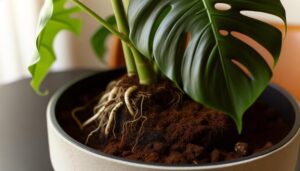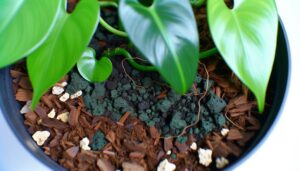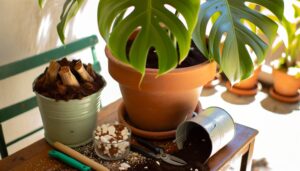What's Wrong With My Monstera Deliciosa
Your Monstera Deliciosa may be struggling due to overwatering, causing root rot and yellowing leaves from chlorosis. Check for brown spots, indicating fungal or bacterial infections, exacerbated by high humidity and poor air circulation.
Drooping stems often result from insufficient light or overwatering. Leaf curling suggests underwatering, low humidity, or pest infestations like spider mites and thrips.
Slow growth typically points to inadequate light or nutrient deficiencies. Detect root rot by examining for discolored, mushy roots with foul odors.
Proper care involves adjusting watering practices, ensuring ideal light, and managing pests meticulously. For a thorough guide, explore the detailed sections.

Key Takeaways
- Yellowing leaves often indicate overwatering, leading to root rot and nutrient deficiencies.
- Brown spots can signify fungal or bacterial infections exacerbated by high humidity and poor air circulation.
- Drooping stems usually result from overwatering and insufficient light, affecting root health and photosynthesis.
- Leaf curling may be caused by underwatering, low humidity, or pest infestations like spider mites and thrips.
- Slow growth can indicate inadequate light, nutrients, or watering, requiring bright, indirect sunlight and balanced monthly fertilization.
Yellowing Leaves
Yellowing leaves on your Monstera deliciosa are often a sign of overwatering, which can lead to root rot and nutrient deficiencies. You'll notice that the lower leaves turn yellow first, a result of chlorosis caused by inadequate oxygen in the root zone. Excess water displaces air pockets in the soil, causing hypoxic conditions harmful to root health.
Check the moisture level by inserting your finger into the soil up to the second knuckle; it should be dry before the next watering. Ensure your pot has sufficient drainage to prevent water stagnation. Utilize a soil mix with good aeration properties, such as a blend of peat, perlite, and pine bark, to maintain optimal moisture levels and prevent future yellowing.
Brown Spots
Brown spots on your Monstera deliciosa frequently indicate fungal infections or bacterial leaf spot, both of which can be worsened by high humidity and poor air circulation.
Fungal pathogens like Septoria leaf spot manifest as small, water-soaked lesions that expand and darken. Alternatively, bacterial leaf spots often appear as irregular, dark, and sunken areas with yellow halos. To diagnose, inspect the underside of the leaves for spores or bacterial ooze.
Make sure the plant isn't overwatered, and improve ventilation by spacing plants adequately or using a fan. Prune affected leaves with sterilized tools to prevent spread. Consider applying a fungicide or bactericide specifically formulated for houseplants.
Regularly check humidity levels, aiming for values around 40-60% to control pathogen proliferation.
Drooping Stems
If your Monstera Deliciosa exhibits drooping stems, you might need to assess your watering frequency and light exposure.
Overwatering can lead to root rot, compromising the plant's structural integrity.
Additionally, insufficient light can hinder photosynthesis, causing the stems to weaken and sag.
Watering Frequency Issues
When you notice drooping stems on your Monstera deliciosa, it's often a sign that your watering frequency needs adjustment, either because of overwatering or underwatering. Examine the soil moisture level—soggy soil indicates overwatering, leading to root rot and lack of oxygen.
Conversely, dry, compacted soil suggests underwatering, causing dehydration stress. To maintain peak conditions, water your Monstera when the top 2-3 inches of soil feel dry. Guarantee proper drainage to prevent waterlogging and root rot. Utilize a moisture meter for precise readings.
Insufficient Light Exposure
In addition to watering issues, insufficient light exposure can also cause drooping stems in your Monstera deliciosa, as the plant struggles to photosynthesize effectively. When Monstera lacks adequate light, it can't produce enough energy, leading to elongated, weak stems. You may notice etiolation, where stems stretch towards the light source, appearing leggy and less robust.
The chlorophyll in the leaves might also become less vibrant, turning pale. Place your Monstera in bright, indirect light to optimize its photosynthetic efficiency. Avoid direct sunlight, which can scorch the leaves, causing further stress. Monitor light levels using a light meter, aiming for around 100-500 foot-candles.
Consistent, adequate light will help maintain turgor pressure, ensuring your Monstera remains vigorous and upright.
Leaf Curling
When your Monstera Deliciosa's leaves curl, you're likely dealing with issues like underwatering, dry soil, or pest infestations. Check the soil moisture levels and inspect for signs of spider mites or aphids.
Environmental stressors such as low humidity and temperature fluctuations can also cause leaf curling.
Underwatering and Dry Soil
Why does your Monstera Deliciosa's foliage curl and crisp at the edges despite your best efforts? Underwatering and dry soil are often the culprits.
When the substrate lacks sufficient moisture, the plant's roots can't absorb enough water, leading to desiccation. You'll notice leaf margins curling inward and becoming brittle, a clear indicator of hydric stress.
Inspect the soil: if it's parched an inch below the surface, your Monstera is thirsty. Maintain a consistent watering schedule, allowing water to thoroughly saturate the root zone. Utilize a well-draining potting mix to prevent waterlogging while retaining moisture.
Additionally, consider misting the leaves to enhance humidity levels, replicating the plant's natural tropical habitat and easing dehydration symptoms.
Pest Infestation Issues
Another factor contributing to leaf curling in your Monstera Deliciosa could be a pest infestation, where insects like spider mites and thrips extract sap, causing foliar distortion and discoloration. These pests compromise the plant's ability to photosynthesize effectively, leading to stunted growth and weakened structural integrity.
To identify a pest infestation, look for:
- Webbing: Fine, silken webbing often indicates spider mites.
- Speckling and yellowing: Thrips cause tiny, discolored spots and a silvery sheen on leaves.
- Visible insects: Small, mobile pests can sometimes be seen on the undersides of leaves.
Regularly inspect your Monstera for these signs using a magnifying glass. If you notice any symptoms, promptly treat the plant with appropriate horticultural oil or insecticidal soap to mitigate damage.
Environmental Stress Factors
Environmental stress factors like improper watering, inadequate humidity, and extreme temperatures can cause leaf curling in your Monstera Deliciosa. When you overwater, roots may suffocate, leading to reduced transpiration and subsequent leaf curling.
Conversely, underwatering results in dehydration, making leaves curl to minimize water loss. Low humidity levels can exacerbate this condition; Monstera Deliciosa thrives in 60-80% humidity. Extreme temperatures, particularly below 50°F or above 85°F, can induce physiological stress, manifesting as leaf curling. Make sure you're maintaining stable indoor temperatures and avoiding drafts.
Use a hygrometer to monitor humidity, and adjust watering schedules based on soil moisture levels. By optimizing these environmental conditions, you'll mitigate leaf curling and promote healthier growth in your Monstera Deliciosa.
Slow Growth
A Monstera Deliciosa exhibiting slow growth often indicates suboptimal light conditions, insufficient nutrients, or inadequate watering practices. To address this, make sure your plant receives bright, indirect sunlight. Direct sunlight can scorch the leaves, while too little light stunts its growth.
Regularly feed your Monstera with a balanced, water-soluble fertilizer to supply essential macronutrients like nitrogen, phosphorus, and potassium.
- Light: Place near an east or west-facing window.
- Nutrients: Apply fertilizer monthly during the growing season.
- Watering: Maintain consistent soil moisture, avoiding waterlogged conditions.
Monitor the internodal spacing; elongated gaps between leaves suggest light deficiency. Also, observe leaf coloration; pale or yellowing leaves may indicate nutrient shortages.
Root Rot
Detecting root rot in your Monstera Deliciosa requires examining the root system for mushy, discolored roots and foul odors, indicating fungal or bacterial infection. Start by gently removing the plant from its pot, exposing the roots.
Healthy roots should be firm and white, while affected roots appear brown or black, soft to the touch, and emit a rancid smell. Overwatering often causes root rot, as excess moisture creates an anaerobic environment conducive to pathogens like Pythium and Phytophthora.
Utilize sterile pruning shears to trim the diseased roots, ensuring you cut back to healthy tissue. Afterward, repot the Monstera in fresh, well-draining soil and a sanitized container. Adequate aeration and drainage are paramount to prevent recurrence.
Pest Infestation
Pest infestations in your Monstera Deliciosa often manifest as visible damage to leaves, including yellowing, browning, or spotting, as well as the presence of insects like spider mites, mealybugs, and scale. These pests can cause chlorosis and necrosis by feeding on the plant's sap, leading to stunted growth and weakened structural integrity.
To identify and manage pest infestations, observe the following signs:
- Spider mites: Look for fine webbing and tiny, discolored specks on the leaves.
- Mealybugs: Notice cottony white masses at leaf joints and undersides.
- Scale insects: Detect hard, shell-like bumps on stems and foliage.
Implementing integrated pest management (IPM) strategies, such as using insecticidal soap or neem oil, guarantees effective control while minimizing harm to your Monstera.
Conclusion
Well, congratulations! You've managed to turn your Monstera deliciosa into a botanical disaster zone. Yellowing leaves? Clearly, it's just your plant screaming for water.
Brown spots? Oh, it's just the plant's way of adding some 'character'. Drooping stems? They're simply practicing yoga.
Leaf curling, slow growth, root rot, and pests? Think of them as an organic art installation.
Remember, plants are like pets—they'll thrive with a drop of care and an ocean of attention. Happy gardening!






